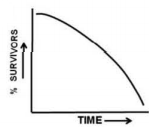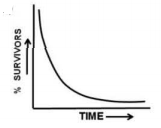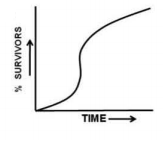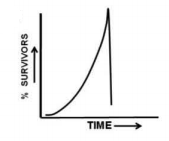 Multiple Choice Questions
Multiple Choice QuestionsThe use of Kruskat Wallis test is most appropriate in which of these cases?
There are more than two groups and each group is normally distributed.
There are more than two groups and the distribution in each group is normal.
There are two groups and the distribution in each group is normally distributed.
There are two groups and the distribution in each group is not normal
Fossils of the same species of freshwater reptiles have been found in South America and Africa. Based on the current understanding, which of the following is the best possible explanation for this pattern?
The same species originated and evolved independently in these two places.
Species migrated from Africa to establish new populations in South America.
Species migrated from South America to establish new populations in Africa.
South America and Africa were joined at some point in Earth's history
During which of the following major mass extinction events, over 95% of the marine species disappeared from the planet Earth?
Ordovician
Devonian
Permian
Triassic
Which one of the following statements supports the concept of trade-off in the evolution of life-history traits?
Level of parental care and clutch size are positively correlated.
Animals maturing early tend to live longer.
An increase in seed size is usually associated with a decrease in seed number.
Allocation of higher energy for reproduction leads to higher population growth.
Which of the following periods is known as "Age of Fishes"?
Devonian
Jurassic
Cambrian
Carboniferous
Which of the following is NOT an assumption of the Hardy-Weinberg model?
Population mates at random with respect to the locus in question.
Selection is not acting on the locus in question.
One allele is dominant and the other is recessive at this locus.
The population is effectively infinite in size.
Which of the following geological period is characterized by the first appearance of mammals?
Tertiary
Cretaceous
Permian
Triassic
In which of the following mating systems there is likely to be NO conflict of interest over reproductive success between the sexes?
Polyandry
Monogamy
Promiscuity
Polygamy
C.
Promiscuity
In promiscuity, there is no conflict of interest over reproductive success between the sexes.
In a natural system, a species producing a large number of offsprings, with little or no parental care, generally exhibits which one of the following kinds of survivorship curves?




A population of non-poisonous butterflies have the same colour pattern as some highly poisonous butterflies. Assume that the population of non-poisonous butterflies is higher thanthe population of poisonous butterflies. Given this, what will be the impact of this mimicry on the fitness of the population of the poisonous butterflies in the presence of the predator?
It will lower the fitness, that is, the fitness of the mimic is negatively frequency-dependent.
It will increase the fitness, that is, fitness of the mimic is positively frequency-dependent.
It will not affect the fitness, that is, fitness of the mimic is frequency independent.
It will increase the fitness, that is, the fitness of the mimic is negatively frequency-dependent.
